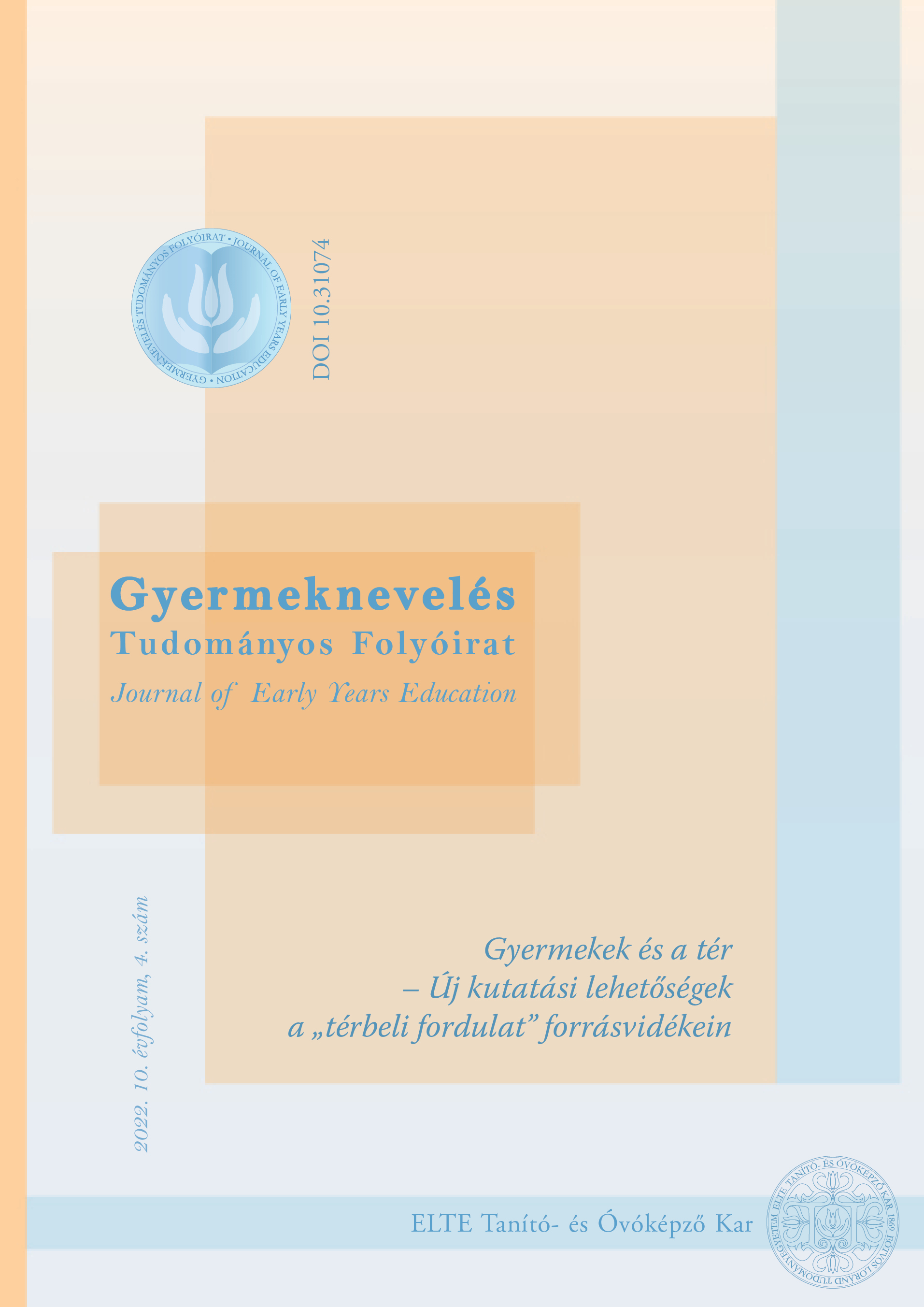Tanulási tér és tanulási környezetek kapcsolatrendszere a környezeti nevelésben.
Elméleti megközelítés a környezeti nevelés tanulási környezeteinek vizsgálatához
DOI:
https://doi.org/10.31074/gyntf.2022.4.245.255Kulcsszavak:
tanulási tér, tanulási környezet, környezeti nevelésAbsztrakt
A tanulásalakító tényezők kölcsönösen összefüggő rendszerben alakítják a tanulás folyamatát, így a tanulás támogatásának sikerességét az határozza meg, hogy miként értelmezzük a tanulási tér és a tanulási környezet kapcsolatrendszerét. Az eltérő fogalomhasználat sok esetben eltérő elméleti megközelítéseket jelent. A környezeti nevelés esetében ráadásul a környezet fogalom használata egybemosódhat a tanulási környezet értelmezésében megjelenő fogalmakkal. Megközelítésünkben elválasztjuk a tanulási tér és a tanulási környezet fogalmát. A tanulási környezetet egy olyan, a tanulásalakító tényezők mentén folytonosan alakuló interakciós egységként kezeljük, amelyben a tanuláshoz köthető reflexiók folytonosak, és amelyben az egyén tanulása és a közösségi tanulás tulajdonképpen egymás feltételeként írható le. Tanulmányunkban a tanulási környezetek értelmezésének egyféle elméleti megközelítését írjuk le abból a célból, hogy rávilágítsunk a környezeti nevelés fogalmi rendszerében rejlő kapcsolódási pontokra.
Letöltések
Hivatkozások
Adedokun, O. A., Parker, L. C., Henke, J. N. & Burgess, W. D. (2017). Student perceptions of a 21st century learning space. Journal of Learning Spaces, 6(1), 1–13.
Armstrong, J. B. & Impara, J. C. (1991). The impact of environmental education program on knowledge and attitude. Journal of Environmental Education, 22(4), 36–40. https://doi.org/10.1080/00958964.1991.9943060
Banyard, P. & Underwood, J. (2008). Understanding the learning space. eLearning Papers, 1(9),
Bélanger, P. (2003). Learning environments and environmental education. New directions for adult and continuing education, (99), 79–88. https://doi.org/10.1002/ace.112
Kálmán, B. (2006). Tanulási környezet–A diákok szemével. Lannert, J. & Nagy, M. (Eds.), Az eredményes iskola. OKI.
Brown, P. C., Roediger III, H. L. & McDaniel, M. A. (2014). Make it stick: The science of successful learning. Harvard University Press. https://doi.org/10.2307/j.ctt6wprs3
Corbett, J. (2002). Supporting inclusive education. Routledge. https://doi.org/10.4324/9780203453339
De Corte, E., Verschaffel, L., Entwistle, N. & Van Marrienboer, J. (2003, Eds.), Powerful Learning Environments: Unravelling Basic Components and Dimensions. Pergamon Press.
De Young, R. (1999). Environmental psychology. Kluwer Academic Publishers
Ellis, R. A. & Goodyear, P. (2016). Models of learning space: Integrating research on space, place and learning in higher education. Review of Education, 4(2), 149–191. https://doi.org/10.1002/rev3.3056
Engeström, Y. (1987). Learning by expanding: An activity-theoretical approach to developmental research. Orienta-Konsultit. https://doi.org/10.1023/A:1008648532192
Engeström, Y. (1999). Expansive visibilization of work: An activity-theoretical perspective. Computer Supported Cooperative Work, 8, 63–93.
Engeström, Y. & Engeström, Y. (2003). The horizontal dimension of expansive learning: weaving a texture of cognitive trails in the terrain of health care in Helsinki. In Achtenhagen, F. & John, E. G. (Eds.), Milestones of vocational and occupational education and training Bertelsmann.
Feffer, M. (1988). Radical constructivism. New York University
Fennessey, G. M., Livingston, S. A., Edwards, K. J., Kidder, S. J. & Fraser, B. J. (2002). Learning Environments Research: Yesterday, Today and Tomorrow. In Goh, S. C. & Khine, M. S. (Eds.), Studies In Educational Learning Environments. An International Perspective (pp. 1–25). Nanyang Technological University.
Forgó, S., Hauser, Z. & Kis-Tóth, L. (2004). Tanulás tér-és időkorlátok nélkül. Iskolakultúra, 14(12), 123–139. https://doi.org/10.1142/9789812777133_0001
Instance, D. (2011). Innovative Learning Environments: An international OECD project. Seminar Series. Victoria Centre for Strategic Education (CSE).
Komenczi, B. (2016). Tanulási környezet a 21. század elején. GlobeEdit.
Kozma, T. (2016). A tanulás térformáló ereje. Educatio, 25(2), 161–169.
Manninen, J., Koivunen, A., Kuittinen, E., Luukanne, S., Sarkka, A. & Passi, S. (2007). Environments that Support Learing: An Introduction to the Learning Environments Approach. Finnish National Board of Education. Helsinki.
Nemzeti Környezeti Nevelési Stratégia (2010, October). Magyar Környezeti Nevelési Egyesület. https://mek.oszk.hu/13400/13463/13463.pdf
OECD (2008, 2013). Innovative Learing Environments, Educational Research and Innovation. OECD Publishing. (2022.10.09.) 10.1787/9789264203488-en
Palmer, J. A. (1998). Environmental Education in the 21st Century: Theory, Practice, Progress and Promise. Routledge.
Qvortrup, A., Wiberg, M., Christensen, G., & Hansbøl, M. (2016, Eds.). On the definition of learning. University Press of Southern Denmark.
Takács Sánta, A. (2008). Bioszféra-átalakításunk nagy ugrásai. L’Harmattan.
Tókos, K., Rapos, N., Szivák, J., Lénárd, S. & Kárász, J. T. (2020). Osztálytermi tanulási környezet vizsgálata. Iskolakultúra, 30(8), 41–61. https://orcid.org/0000-0002-6198-482X
Varga, A. (2004). A környezeti nevelés pedagógiai, pszichológiai alapjai. Eötvös Loránd Tudományegyetem Bölcsészettudományi Kar, Neveléstudományi Doktori Iskola.
Vitousek, P. M. (1992). Global environmental change: an introduction. Annual review of Ecology and Systematics, 1–14. https://doi.org/10.1146/annurev.es.23.110192.000245
Wilcox, S. (2004). Cognitive iconicity: Conceptual spaces, meaning, and gesture in signed language. Cognitive Linguistics, 15(2), 119–147. https://doi.org/10.1515/cogl.2004.005
##submission.downloads##
Megjelent
Hogyan kell idézni
Folyóiratszám
Rovat
License
Copyright (c) 2022 Szerző

This work is licensed under a Creative Commons Attribution-NonCommercial-ShareAlike 4.0 International License.

